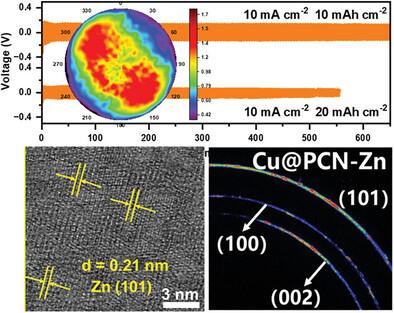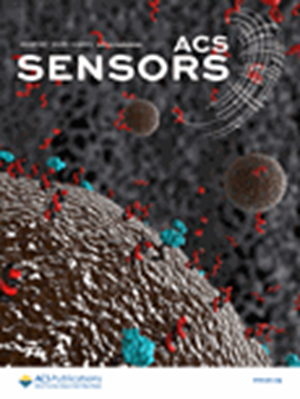Oriented and Continuous Phase Epitaxy Enabled by A Highly Dendrite-Resistant Plane Toward Super-High Areal Capacity Zinc Metal Batteries
IF 8.2
1区 化学
Q1 CHEMISTRY, ANALYTICAL
引用次数: 0
Abstract
Unstable Zn metal anodes with dendrites/side reactions are becoming the main obstacle to the practical application of zinc-based aqueous batteries. Epitaxial growth has been considered to be an effective strategy for solving these issues, especially for inducing the (002) plane growth. Nonetheless, the (002)-textured Zn is difficult to achieve highly stable Zn anode under high capacity resulting from its large lattice distortion. Herein, the Cu single atom anchored polymeric carbon nitride (Cu@PCN) is synthesized by a facile thermal polymerization method. Serving as multifunctional protective layer on Zn surface, the Cu@PCN can provide massive nucleation sites at a nano-level and uniformize the electron distribution through coordination engineering. Optimizing the coordination structures of single Cu and N atoms within the carbon matrix enables a redistribution for electric field and regulates ion flux. More importantly, this coordination strategy with single atoms is first reported to customize oriented and continuous phase epitaxy along highly dendrite-resistant Zn(101) plane by reducing (101) surface energy. This pattern of oriented dense deposition leads to stable and reversible Zn plating/stripping is achieved, which delivers an extended cycling life of 550 h at 10 A cm−2, 20 mAh cm−2. The practical full cell also displays stable performance for 1200 cycles.

利用高抗枝晶平面实现定向和连续相外延,开发超高容量锌金属电池
具有枝晶/侧面反应的不稳定锌金属阳极正成为锌基水性电池实际应用的主要障碍。外延生长一直被认为是解决这些问题的有效策略,尤其是在诱导 (002) 平面生长方面。然而,(002)纹理的锌由于其较大的晶格畸变,很难在高容量条件下获得高度稳定的锌阳极。本文采用简便的热聚合方法合成了单原子锚定铜聚合物氮化碳(Cu@PCN)。作为 Zn 表面的多功能保护层,Cu@PCN 可在纳米级提供大量成核位点,并通过配位工程使电子分布均匀。通过优化碳基质中单个铜原子和 N 原子的配位结构,可以重新分配电场并调节离子通量。更重要的是,据首次报道,这种单原子配位策略可通过降低(101)表面能,沿高度抗枝晶的 Zn(101)平面定制定向和连续相外延。这种定向致密沉积模式实现了稳定和可逆的锌镀层/剥离,从而在 10 A cm-2 和 20 mAh cm-2 的条件下延长了 550 小时的循环寿命。实用的全电池在 1200 次循环中也显示出稳定的性能。
本文章由计算机程序翻译,如有差异,请以英文原文为准。
求助全文
约1分钟内获得全文
求助全文
来源期刊

ACS Sensors
Chemical Engineering-Bioengineering
CiteScore
14.50
自引率
3.40%
发文量
372
期刊介绍:
ACS Sensors is a peer-reviewed research journal that focuses on the dissemination of new and original knowledge in the field of sensor science, particularly those that selectively sense chemical or biological species or processes. The journal covers a broad range of topics, including but not limited to biosensors, chemical sensors, gas sensors, intracellular sensors, single molecule sensors, cell chips, and microfluidic devices. It aims to publish articles that address conceptual advances in sensing technology applicable to various types of analytes or application papers that report on the use of existing sensing concepts in new ways or for new analytes.
 求助内容:
求助内容: 应助结果提醒方式:
应助结果提醒方式:


